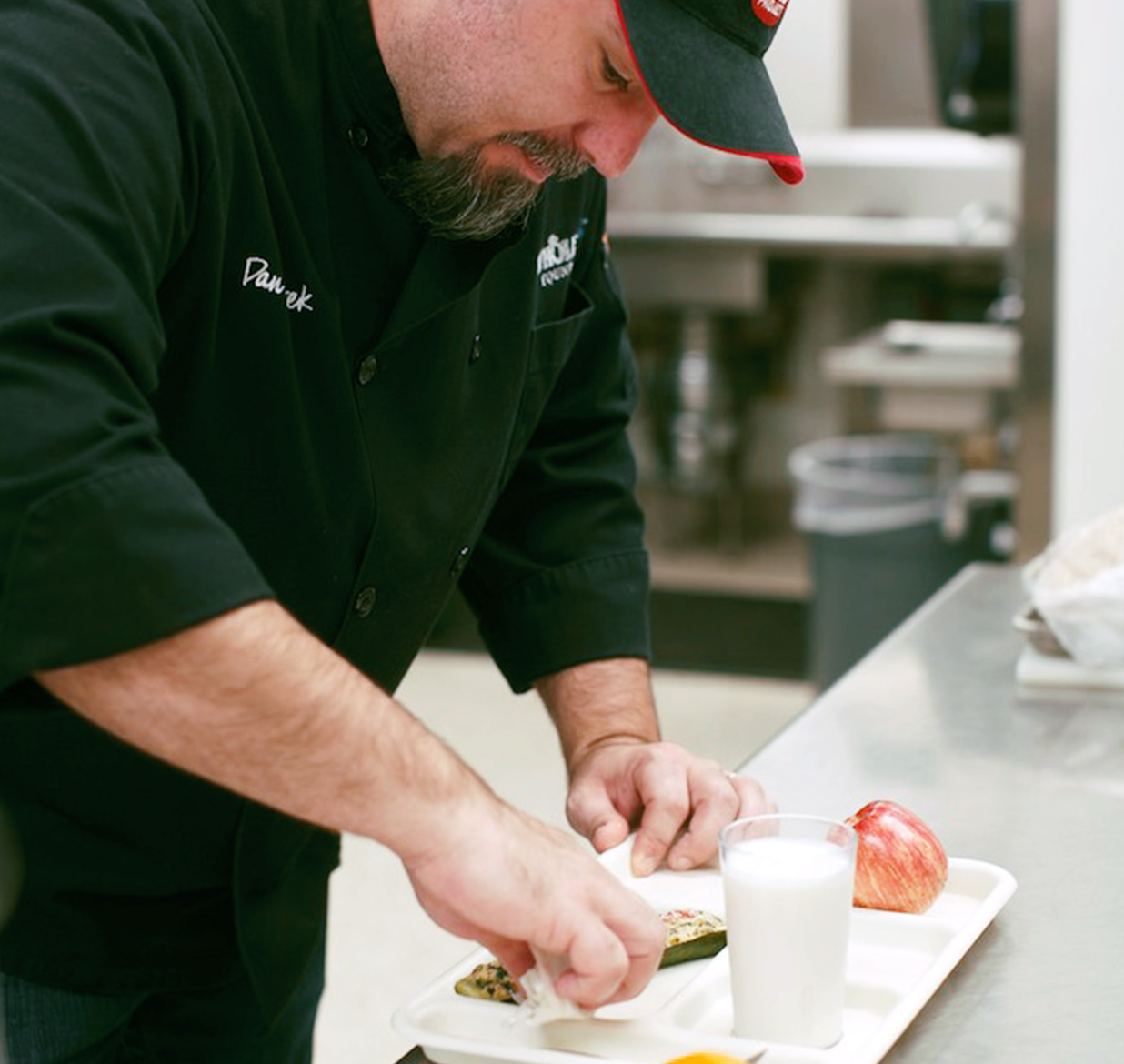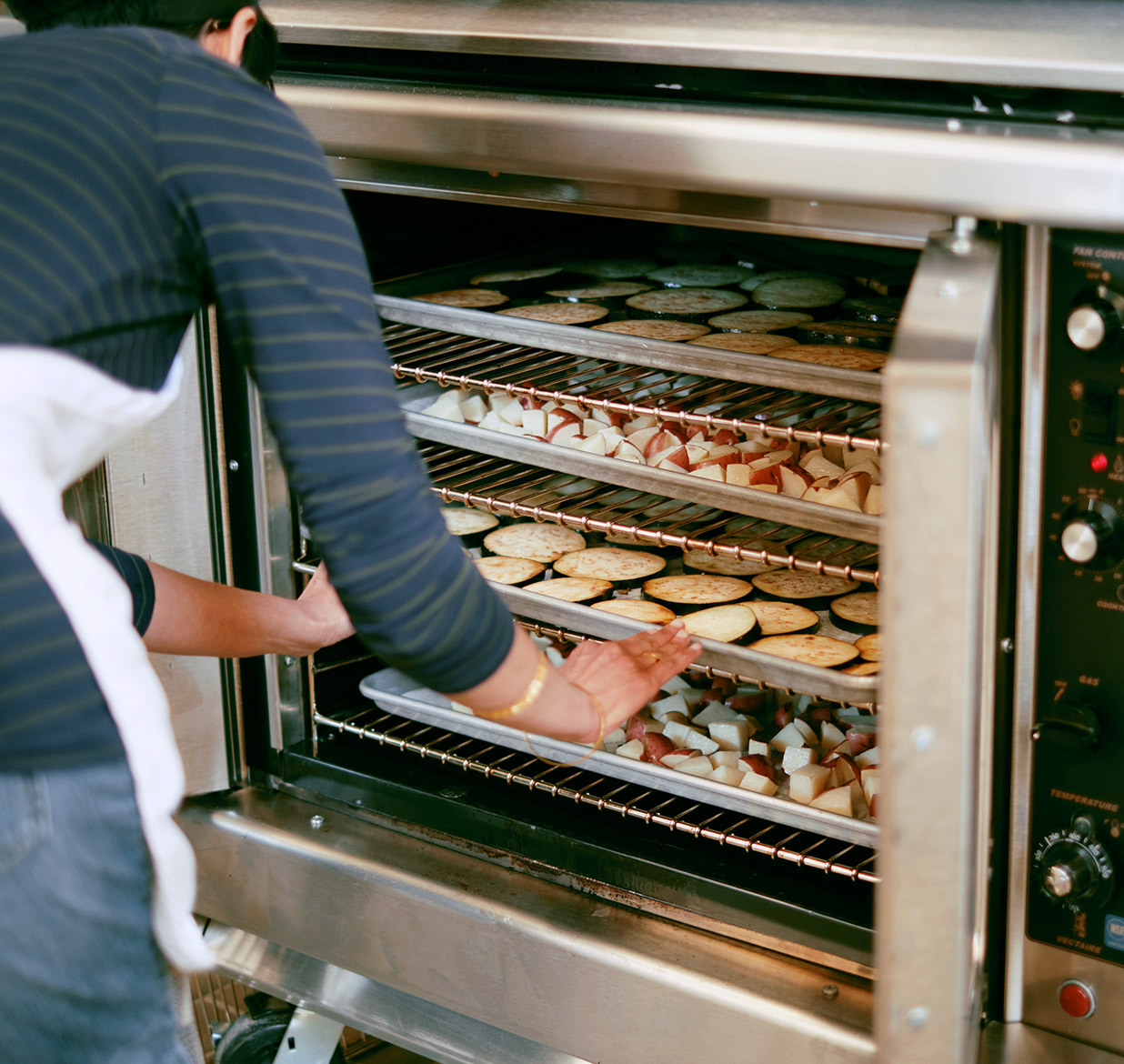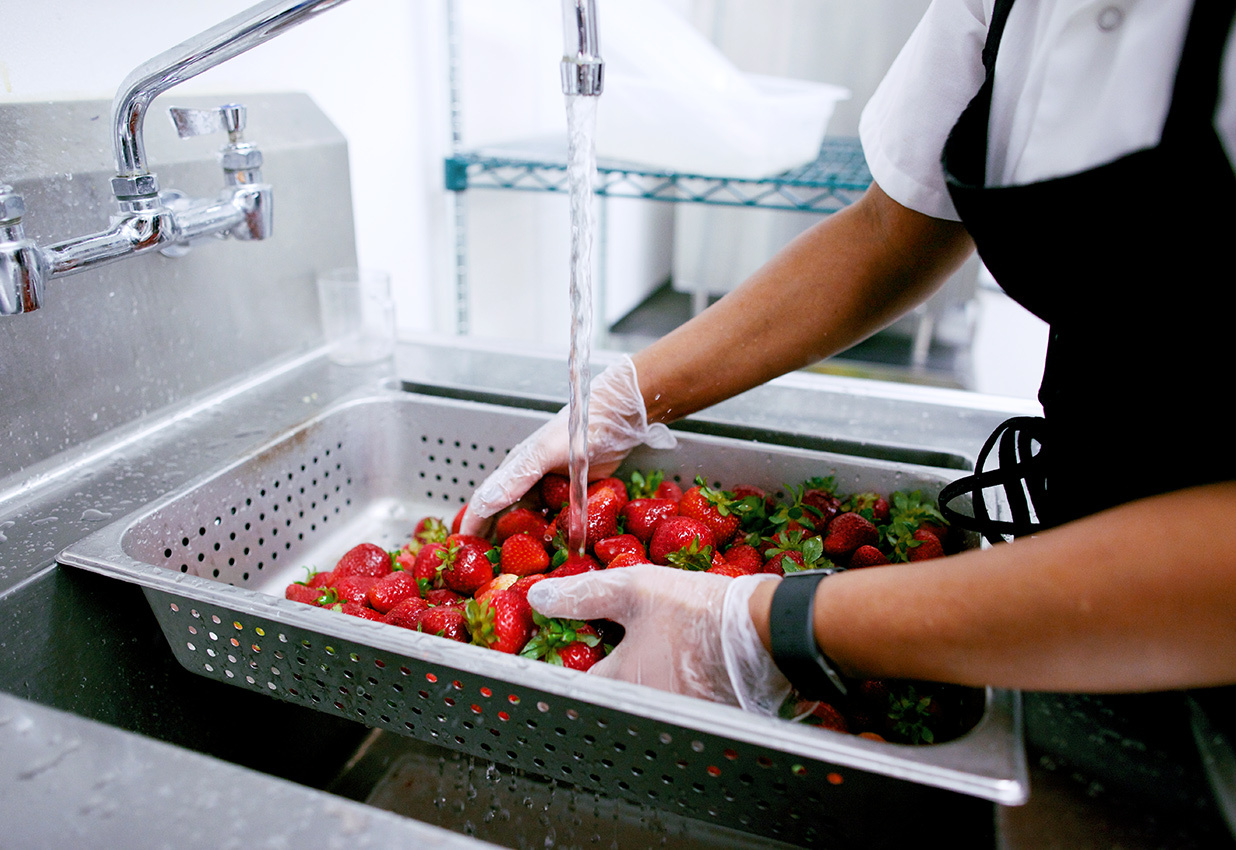
Facilities
Among the many challenges food service directors take on, becoming an expert in facilities design and equipment is a particularly tough one. Directors can have a wide range of facility and equipment experience – some have none, while others may have served as project manager for the construction of a central production facility.
Whether the project involves a few pieces of equipment, or the design of several school kitchens, or even a larger project like a food service warehouse and central kitchen, the food service director must know enough about food service facility design and equipment to make informed decisions in the process.
Learn more about facilities in the School Food Institute’s Operational Models course. Apply for a scholarship here.

Facilities
Among the many challenges food service directors take on, becoming an expert in facilities design and equipment is a particularly tough one. Directors can have a wide range of facility and equipment experience – some have none, while others may have served as project manager for the construction of a central production facility.
Whether the project involves a few pieces of equipment, or the design of several school kitchens, or even a larger project like a food service warehouse and central kitchen, the food service director must know enough about food service facility design and equipment to make informed decisions in the process.
Learn more about facilities in the School Food Institute’s Operational Models course. Apply for a scholarship here.
Food service directors are often asked to compromise or scale back on their “dream” facility, or to work with an architect or food service equipment company that they did not choose, as a result of bond projects or pre-existing agreements with the district. Being fully educated and informed allows a director to make the most advantageous decisions and direct resources as effectively as possible in such circumstances.
A good place to start is the excellent handbook for food-service directors developed by the Institute of Child Nutrition (ICN) titled “Purchasing and Facility Design for School Nutrition Programs.” This manual offers in-depth coverage of facility design, from all the equipment and design options to the ramifications of a district’s vision on final decisions.

Equipment Management
Equipment Inventory and Replacement Management
Many school districts have aging kitchen equipment that is more than forty years old. Directors constantly have to decide what equipment to fix, replace, or live without. If the annual food-service budget does not have a line item for depreciation or does not regularly set aside funds for equipment replacement, this necessity has been overlooked or simply unfunded.
Along with aging inventory, most districts have an equipment “graveyard,” where discarded kitchen equipment sits and gathers dust. Savvy food service teams try to recoup some value and bid the equipment goodbye, selling them online, or to companies that specialize in stainless steel.

Equipment Management
Equipment Inventory and Replacement Management
Many school districts have aging kitchen equipment that is more than forty years old. Directors constantly have to decide what equipment to fix, replace, or live without. If the annual food-service budget does not have a line item for depreciation or does not regularly set aside funds for equipment replacement, this necessity has been overlooked or simply unfunded.
Along with aging inventory, most districts have an equipment “graveyard,” where discarded kitchen equipment sits and gathers dust. Savvy food service teams try to recoup some value and bid the equipment goodbye, selling them online, or to companies that specialize in stainless steel.
To support preventive maintenance and replacement management plans, take the time to develop and maintain an equipment inventory that includes the following information:
- Location of the item
- Average production volume for that location
- Purchase order number
- Product model number
- Manufacturer
- Repair history
- Information about the item’s “retirement,” including whether the retired equipment is still within the district
A ten- to twelve-year depreciation cycle is typical for food service equipment, but the actual life of an item depends on maintenance and use. For example, equipment that is used in a central, regional, or base kitchen may see far more use than equipment at a small elementary school operating only 175 days a year. For this reason, using and updating an equipment inventory form is essential. Photos of the equipment are useful, and any change in location should be logged.
In the modern era of scratch cooking, planning for equipment acquisition and maintenance compatible with future operational models, as well as keeping replacement in long-term plans, will make for a safer, cleaner, and more productive work environment for your employees. Though an acquisition cost of $5000 is the common baseline for depreciation, all “non-expendable” equipment (meaning equipment that is not disposable or has a life limited to a year or two) with a value of $500 or more should be inventoried annually. This will make it easy to identify the total value of relevant equipment when planning changes to kitchens or menus.
When setting aside funds for equipment replacement, the annual depreciation amount is a guide that is commonly used; that is, you should set aside funds equal to the amount of depreciation in your budget. If your equipment ages beyond the depreciation period, keep setting aside funds and review your annual equipment tracking document to identify equipment that is slated for replacement. The Food and Nutrition Service offer NSLP Equipment Assistance Grants annually. Tracking your equipment inventory and flagging items for replacement as well developing a wish list that aligns with your programs changes can make the process of completing the federal grant applications much more efficient.
Evaluating Facilities for Program Change or Expansion
When considering changes to your menu or your services, like making salad bars a regular feature of your reimbursable meal, or expanding breakfast services to a breakfast-in-the-classroom model, you must assess the compatibility of your buildings and equipment.
If you have maintained a by-site equipment inventory, you will have a good idea of where you may need improvement or additional investment. For assessment purposes, we have created a Salad Bar Site Assessment Tool [Spanish Version] and a Breakfast Assessment Tool to assist you in evaluating your district for change.


Evaluating Facilities for Program Change or Expansion
When considering changes to your menu or your services, like making salad bars a regular feature of your reimbursable meal, or expanding breakfast services to a breakfast-in-the-classroom model, you must assess the compatibility of your buildings and equipment.
If you have maintained a by-site equipment inventory, you will have a good idea of where you may need improvement or additional investment. For assessment purposes, we have created a Salad Bar Site Assessment Tool [Spanish Version] and a Breakfast Assessment Tool to assist you in evaluating your district for change.
Production Models
Alternatives to Site-Based Production: Regional and Central Production
The most challenging aspect of K–12 operations is balancing the cost of production while shifting toward the desired food and menu model. The current era of processed food affects every venue of food available to children and adults.
Although school districts do need extra resources and dedication to step outside the norm and innovate, it is not impossible. Consolidating the production model to a single site, or fewer sites, is the most cost-effective and efficient approach to balancing investment with the desired outcome of better foods, better access, and better service. Read more about centralized production and Central Kitchens here.
While centralization is the most efficient, there are many other ways to consolidate, such as regional kitchens or specific kitchens to handle particular menu areas, like produce production. Scaling up the means of production allows greater control over not only the resources aggregated for production (i.e., the food and supplies) but also the labor, even though a consolidated production model requires more specialized and expensive staffing.
Why Consolidate?
The primary reasons to consider consolidation are quality, efficiency, and cost. Taking advantage of the opportunity to scale up will have positive, long-term results.
For a district committed to improving food quality through implementing whole-ingredient meal production, consolidation offers many advantages:
- Ensures that the quality of the food is consistent district-wide – the greatest hurdle in successfully making the shift to scratch production.
- Creates efficiencies in food procurement by bringing a majority of the food into a central location.
- Reduces food costs, both through the price advantages of a single (or fewer) delivery location/s and the lower cost of inventory at the sites.
- Limits the specialized labor required for large-scale scratch cooking to a central location.
- Focus at the sites can be turned more to the students and the service, which will help drive higher meal counts.
- Typically requires less labor at the satellite school sites, which balances the higher cost of labor required at the production site/s.
With central or regional production facilities, it may also be possible to expand catering and contract services beyond the boundaries of the district, which can generate additional revenue for the department. In districts with older building infrastructures, or those that have limited capacity for improvements to school-site kitchen facilities, a central production facility consolidates the investment in one location and simplifies equipment needs at the site level.
Without consolidation, the alternative is to maintain and improve multiple older sites while trying to keep meal quality consistent from site to site – an extremely difficult proposition in the scratch-cook production environment. Producing complex meals with fresh ingredients at multiple sites is challenging, particularly at older sites that may need significant facility improvements to prepare them for scratch cooking. For example, older kitchens with just one dual-bowl sink would face the risk of contamination if they had to prep salad bar ingredients and sort raw poultry in the same morning. Consolidation may be the most effective way to respond to these kinds of specific limiting factors.
Central Kitchens
Central kitchens - sometimes referred to as Culinary Centers - are the most integrated version of consolidated production. Learn more about this model and read a case study from Boulder Valley School District in the Central Kitchens section.
Budget Development When Planning Consolidation
When considering a regional or centralized production model, labor is by far the largest expense. Developing a labor comparison is a key part of planning.
The scope of the comparison depends on the current staffing model size, the potential impact of the reorganization, and the length of time needed to complete the reorganization. We usually recommend a workbook that compares labor figures for the current year to projected figures for the next two years. This Sample Reorganization Worksheet is based on consolidation with an estimated completion time of two years.
Consolidation can also affect food costs. By centralizing production and purchasing, food costs can lower significantly. For budget development purposes, you can utilize current procurement and participation data to allocate a sufficient amount. Additionally, vendors may be much more interested in providing services to a centralized or regionalized production environment (rather than by-site delivery).
Other areas to be considered include transportation, warehouse management, menus, production schedules, labor at the satellite sites, purchasing, and all recordkeeping and transaction processes. In most cases, a shift to consolidated production will require a significant reorganization of the department’s workflow and systems.
Funding
Funding Capital Improvements
Capital improvements are defined as the acquisition of land, buildings, and equipment. For capital purchases, food service funds are limited to equipment that is considered reasonable and necessary to provide quality meals. Money spent on capital expenditures that add to the material value of the school building and related facilities (or appreciably prolong its intended life) should be the responsibility of the school district.
Funding major renovations, equipment acquisition, or outright new construction usually exceeds the capability of a food service department, even one that regularly posts a healthy fund balance. In these cases, possible funding sources include:
- Grants, such as federal equipment assistance grants
- Donations from an outside foundation
- Direct purchase or acquisition by the school district general fund
- Inclusion in a local school bond measure
Because every state has different school bond regulations, you should work with district administration to explore this route. It is also prudent to discuss possible capital improvements with your state’s department of education to determine the source of the funds.
Recommended Next Topic: Central Kitchens
Central kitchens are becoming a more popular option for school districts looking to streamline and expand their school food operations. While centralized production is not one-size-fits-all, this model offers a number of opportunities for districts with the capacity and incentive to plan and construct a new facility.
Recommended Next Topic: Central Kitchens
Central kitchens are becoming a more popular option for school districts looking to streamline and expand their school food operations. While centralized production is not one-size-fits-all, this model offers a number of opportunities for districts with the capacity and incentive to plan and construct a new facility.



